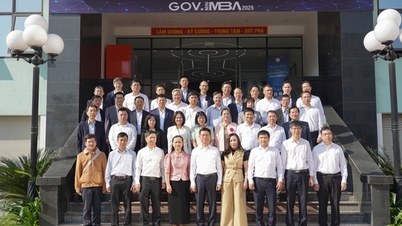
Online trial.
Digital transformation – the political task of the modern judiciary
On December 22, 2024, the Politburo issued Resolution 57-NQ/TW on science , technology, innovation and national digital transformation development, which is considered a "road map" for the process of modernizing the State apparatus.
Then, on March 18, 2025, the Supreme People's Court Party Committee issued Resolution No. 03, affirming that digital transformation is a key, long-term and strategic task in judicial reform.
Mr. Ngo Hoai Thuong, Deputy Director in charge of the Supreme People's Court's Information Technology Department, said: "Digital transformation is not just about computerizing work processes, but also about changing the way the entire system operates, from administration, management to trial and provision of public justice services."
After only half a year of implementing Resolution 57, the Court sector has recorded a series of specific results. The "Judge Virtual Assistant" software, an artificial intelligence (AI) application developed by the Information Technology Department, has assisted judges in looking up files, comparing precedents, extracting legal documents and synthesizing case data in just a few seconds.
The campaign to digitize 2.5 million marriage judgments and decisions, implemented in 90 days and nights, has helped synchronize data with the National Population Database, contributing to cleaning up civil status information and improving management efficiency.
The entire industry has also completed the connection of the National Document Interconnection Axis, ensuring that electronic documents are sent and received smoothly within the Court system and between state agencies.
District 1 People's Court - where justice "touches" people through Zalo and QR codes
Local courts are also proactively seeking to incorporate technology into every stage of the trial process. In particular, District 1 People’s Court, Ho Chi Minh City is considered a typical model of a grassroots e-Court.
From October 2023, District 1 People's Court will officially operate a comprehensive digital system, from internal records management to utilities serving the people.
Here, all judgments, decisions, and procedural documents are assigned an electronic identification code, allowing people to verify the authenticity of the document right on their phones.
The Court also opened a channel called "District 1 People's Court" on Zalo, where litigants can send requests, look up records, track case progress, or receive electronic copies and extracts without having to come directly to the headquarters.
Chief Justice Nguyen Quang Huynh, Head of the Digital Transformation Board of District 1 People's Court, said: "On average, each judge has to handle 150-200 cases/year, while the number of secretaries is small. Digitalization helps optimize drafting time, manage progress and retrieve file data instantly. With one click, judges can view the entire litigation process of a case."
According to Mr. Huynh, digitization not only helps save time but also restructures the entire workflow from receiving, adjudicating to archiving in a closed, unified and transparent model. People can not only track their cases but also compare original documents on the system to ensure accuracy.
Digital court
Not only applying technology in judicial administration, District 1 People's Court has entered the digitalization phase of trial activities.
According to Chief Justice Nguyen Quang Huynh, "electronic justice" is not just a technical transformation, but a reform of thinking. When all data is digitized, judges can focus on the legal nature of the case, and people can access justice more quickly and fairly.
Despite many achievements, the digital transformation journey of the Court sector still faces many challenges. The technical infrastructure is not yet synchronized, the data transmission network is not stable, and especially there is a lack of specialized IT human resources in many units.
In addition, the legal framework for online trials and electronic data storage is still in the process of being completed. Some procedural regulations have not yet been adjusted to the reality of digital work, leading to confusion when implementing it on a large scale.
Chief Justice Nguyen Quang Huynh said that this is "an inevitable step but requires perseverance and inter-sectoral coordination". He affirmed that the construction of the e-Court does not affect the independence of the judiciary, but on the contrary, enhances objectivity, publicity and control of the entire litigation process.
According to the direction of the Supreme People's Court, from now until 2027, the entire system will continue to perfect the unified e-Court model, linked with national data platforms and other litigation agencies.
The goal is that all processes, from filing, accepting, litigating, to publicizing the judgment, are done online, transparently, and at the same time significantly reducing the workload for court staff.
Source: https://mst.gov.vn/toa-an-trong-ky-nguyen-so-cong-ly-duoc-van-hanh-tren-du-lieu-197251113090254681.htm




![[Photo] Prime Minister Pham Minh Chinh meets with representatives of outstanding teachers](https://vphoto.vietnam.vn/thumb/1200x675/vietnam/resource/IMAGE/2025/11/15/1763215934276_dsc-0578-jpg.webp)
![[Photo] General Secretary To Lam receives Vice President of Luxshare-ICT Group (China)](https://vphoto.vietnam.vn/thumb/1200x675/vietnam/resource/IMAGE/2025/11/15/1763211137119_a1-bnd-7809-8939-jpg.webp)


























































































Comment (0)